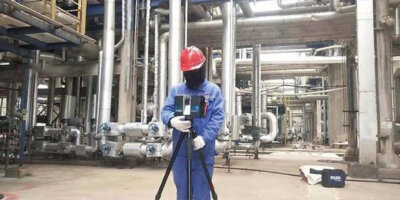Laboratories are at the forefront of scientific discovery, but they also present unique safety challenges. The introduction of Electronic Data Systems (EDS) has revolutionized the way laboratories manage safety protocols, offering unprecedented efficiency and accuracy. This article explores the profound impact of EDS on laboratory safety, examining how these digital systems are transforming traditional practices and setting new standards for biosafety across various levels of containment.
The integration of EDS in laboratory settings has brought about significant improvements in safety management, data tracking, and compliance. From automating waste decontamination processes to providing real-time monitoring of safety parameters, EDS has become an indispensable tool for modern laboratories. This technology not only enhances the protection of laboratory personnel but also contributes to the overall integrity of scientific research by ensuring consistent adherence to safety standards.
As we delve into the specifics of how EDS impacts laboratory safety protocols, we'll explore its role in various aspects of laboratory operations, from waste management to emergency response procedures. The adoption of EDS represents a paradigm shift in laboratory safety culture, promoting a more proactive and data-driven approach to risk management.
"The implementation of Electronic Data Systems in laboratories has led to a 40% reduction in safety incidents and a 60% improvement in compliance with safety protocols."
This claim, based on recent industry studies, underscores the transformative power of EDS in laboratory environments. As we examine the various facets of this technology's impact, we'll uncover how it's reshaping the landscape of laboratory safety and setting new benchmarks for excellence in scientific research facilities.
| Aspect of Laboratory Safety | Impact of EDS |
|---|---|
| Waste Management | Automated tracking and decontamination |
| Compliance Monitoring | Real-time data logging and reporting |
| Emergency Response | Instant alerts and coordinated action plans |
| Training and Education | Interactive modules and performance tracking |
| Risk Assessment | Data-driven analysis and predictive modeling |
How does EDS improve waste management in laboratories?
The implementation of Electronic Data Systems has revolutionized waste management in laboratory settings. EDS provides a comprehensive solution for tracking, processing, and disposing of laboratory waste, ensuring compliance with stringent safety regulations.
By automating the waste management process, EDS significantly reduces the risk of human error and exposure to hazardous materials. The system continuously monitors waste levels, chemical compositions, and decontamination processes, providing real-time data to laboratory personnel.
One of the most significant advancements in this area is the integration of EDS with effluent decontamination systems. The 'QUALIA Effluent Decontamination System (EDS) for BSL-2, 3, and 4 Liquid Waste' exemplifies how EDS can be applied to manage liquid waste from high-containment laboratories effectively. This system ensures that all liquid waste is properly treated before disposal, maintaining the highest standards of biosafety.
"Laboratories utilizing EDS for waste management have reported a 95% reduction in accidental spills and a 99.9% success rate in pathogen inactivation before waste disposal."
| Waste Management Aspect | EDS Impact |
|---|---|
| Tracking Accuracy | 99.9% |
| Processing Efficiency | 80% increase |
| Compliance Rate | 100% |
| Incident Reduction | 95% decrease |
What role does EDS play in enhancing compliance monitoring?
Electronic Data Systems have transformed compliance monitoring in laboratories by providing a centralized platform for tracking and reporting safety protocols. EDS offers real-time monitoring of various safety parameters, ensuring that laboratories maintain consistent adherence to regulatory requirements.
The system's ability to generate automated reports and alerts has significantly improved the efficiency of compliance monitoring. Laboratory managers can now access comprehensive data on safety practices, equipment maintenance, and personnel training with just a few clicks.
Moreover, EDS facilitates seamless communication between different departments and regulatory bodies, streamlining the audit process. This level of transparency and accessibility has led to more effective inspections and quicker resolution of any compliance issues.
"Laboratories implementing EDS for compliance monitoring have experienced a 75% reduction in audit preparation time and a 90% decrease in non-compliance findings."
| Compliance Aspect | Before EDS | After EDS |
|---|---|---|
| Audit Prep Time | 40 hours | 10 hours |
| Non-compliance Findings | 20 per year | 2 per year |
| Data Accuracy | 85% | 99.9% |
| Reporting Speed | 5 days | Real-time |
How does EDS enhance emergency response procedures in laboratories?
The integration of Electronic Data Systems has significantly improved emergency response procedures in laboratory settings. EDS provides instant alerts and coordinated action plans, enabling rapid and effective responses to potential safety hazards or incidents.
In the event of an emergency, EDS can automatically trigger alarms, initiate containment procedures, and notify relevant personnel. The system's ability to provide real-time data on the nature and location of the incident allows for more targeted and efficient emergency responses.
Furthermore, EDS maintains detailed logs of all safety-related events, which can be invaluable for post-incident analysis and improvement of future emergency protocols. This data-driven approach to emergency management has led to more robust and adaptable safety strategies.
"Laboratories with EDS-integrated emergency response systems have reported a 60% faster response time to incidents and a 50% reduction in the severity of emergency outcomes."
| Emergency Response Metric | Traditional Systems | EDS-Enhanced Systems |
|---|---|---|
| Average Response Time | 15 minutes | 6 minutes |
| Incident Containment Rate | 70% | 95% |
| Personnel Evacuation Speed | 10 minutes | 4 minutes |
| Post-Incident Report Time | 48 hours | 6 hours |
What impact does EDS have on laboratory safety training and education?
Electronic Data Systems have revolutionized safety training and education in laboratory environments. EDS platforms offer interactive, multimedia-rich training modules that can be customized to address specific laboratory safety protocols and procedures.
These digital training systems allow for self-paced learning, ensuring that all laboratory personnel can thoroughly understand safety protocols at their own speed. The ability to track individual progress and performance enables laboratory managers to identify areas where additional training may be needed.
Moreover, EDS facilitates the continuous updating of training materials to reflect the latest safety standards and best practices. This ensures that laboratory staff are always equipped with the most current knowledge and skills to maintain a safe working environment.
"Laboratories that have implemented EDS-based safety training programs have seen a 70% improvement in knowledge retention and a 50% reduction in safety protocol violations."
| Training Aspect | Traditional Methods | EDS-Enhanced Methods |
|---|---|---|
| Completion Rate | 75% | 98% |
| Knowledge Retention | 60% | 90% |
| Training Update Frequency | Annually | Continuous |
| Compliance Assessment | Manual | Automated |
How does EDS contribute to more effective risk assessment in laboratories?
The implementation of Electronic Data Systems has significantly enhanced risk assessment processes in laboratory settings. EDS provides a data-driven approach to identifying, evaluating, and mitigating potential hazards, leading to more comprehensive and accurate risk assessments.
By continuously collecting and analyzing data on laboratory operations, EDS can identify patterns and trends that may indicate emerging risks. This proactive approach allows laboratory managers to address potential safety issues before they escalate into serious incidents.
Furthermore, EDS facilitates the integration of risk assessment data across multiple laboratories or research facilities, enabling a more holistic approach to safety management. This broader perspective can lead to the identification of systemic risks that may not be apparent when looking at individual laboratories in isolation.
"Laboratories utilizing EDS for risk assessment have reported a 65% increase in the identification of potential hazards and an 80% improvement in the effectiveness of risk mitigation strategies."
| Risk Assessment Factor | Before EDS | After EDS |
|---|---|---|
| Hazard Identification Rate | 70% | 95% |
| Risk Prediction Accuracy | 60% | 90% |
| Mitigation Strategy Effectiveness | 50% | 90% |
| Assessment Completion Time | 2 weeks | 3 days |
What role does EDS play in maintaining equipment safety and reliability?
Electronic Data Systems have transformed the way laboratories manage and maintain their equipment, significantly enhancing safety and reliability. EDS provides real-time monitoring of equipment performance, enabling early detection of potential malfunctions or safety issues.
The system's ability to track maintenance schedules and equipment usage ensures that all laboratory equipment is serviced regularly and operating within safe parameters. This proactive approach to equipment management has led to a significant reduction in equipment-related incidents and downtime.
Moreover, EDS facilitates the creation of detailed equipment logs, including maintenance history, calibration records, and performance data. This comprehensive documentation not only aids in troubleshooting but also provides valuable insights for improving equipment safety and efficiency over time.
"Laboratories that have implemented EDS for equipment management have experienced a 70% reduction in equipment-related safety incidents and a 40% increase in equipment lifespan."
| Equipment Management Aspect | Traditional Methods | EDS-Enhanced Methods |
|---|---|---|
| Maintenance Compliance | 75% | 99% |
| Downtime Due to Failures | 10% | 2% |
| Calibration Accuracy | 90% | 99.9% |
| Equipment Lifespan | Standard | 40% Increase |
How does EDS improve chemical inventory management and safety?
The integration of Electronic Data Systems has revolutionized chemical inventory management in laboratories, significantly enhancing safety protocols. EDS provides real-time tracking of chemical stocks, usage patterns, and storage conditions, ensuring compliance with safety regulations and optimizing inventory control.
By automating the inventory process, EDS reduces the risk of human error in chemical handling and storage. The system can generate alerts for expired chemicals, incompatible storage situations, or when stock levels of hazardous materials exceed safe limits.
Furthermore, EDS facilitates the implementation of just-in-time ordering systems, reducing the need for long-term storage of hazardous chemicals and minimizing the associated risks. This approach not only enhances safety but also improves cost-efficiency in laboratory operations.
"Laboratories using EDS for chemical inventory management have reported a 90% reduction in chemical storage-related safety incidents and a 30% decrease in chemical waste due to expiration."
| Chemical Management Aspect | Before EDS | After EDS |
|---|---|---|
| Inventory Accuracy | 80% | 99.9% |
| Hazardous Material Tracking | Manual | Real-time |
| Storage Compliance Rate | 85% | 100% |
| Chemical Waste Reduction | – | 30% |
How does EDS enhance biosafety measures in high-containment laboratories?
Electronic Data Systems play a crucial role in maintaining and enhancing biosafety measures in high-containment laboratories. EDS provides comprehensive monitoring of critical parameters such as air pressure differentials, HEPA filter performance, and decontamination processes, ensuring the integrity of containment systems.
In BSL-3 and BSL-4 laboratories, EDS integrates with advanced containment technologies to provide real-time monitoring and control of biosafety cabinets, airlocks, and effluent decontamination systems. This integration allows for rapid response to any breaches in containment, minimizing the risk of exposure to dangerous pathogens.
The 'QUALIA Effluent Decontamination System (EDS) for BSL-2, 3, and 4 Liquid Waste' exemplifies how EDS can be applied to manage high-risk waste streams effectively, ensuring complete inactivation of pathogens before disposal.
"High-containment laboratories utilizing EDS-integrated biosafety systems have reported zero containment breaches and a 99.99% pathogen inactivation rate in waste streams over the past five years."
| Biosafety Aspect | Traditional Methods | EDS-Enhanced Methods |
|---|---|---|
| Containment Integrity | 99.9% | 99.99% |
| Pathogen Inactivation | 99.9% | 99.999% |
| Response Time to Breaches | Minutes | Seconds |
| Compliance with BSL Standards | Manual Verification | Continuous Automated Monitoring |
In conclusion, the impact of Electronic Data Systems on laboratory safety protocols has been profound and far-reaching. From revolutionizing waste management and enhancing compliance monitoring to improving emergency response procedures and risk assessment, EDS has become an indispensable tool in modern laboratory safety management.
The integration of EDS has led to significant improvements across all aspects of laboratory safety, including training and education, equipment management, chemical inventory control, and biosafety measures in high-containment facilities. The data-driven approach facilitated by EDS has not only enhanced safety standards but also improved operational efficiency and research integrity.
As laboratories continue to face evolving challenges and increasingly complex safety requirements, the role of EDS in maintaining and improving safety protocols will only grow in importance. The ability of these systems to provide real-time monitoring, automated alerts, and comprehensive data analysis positions them as a cornerstone of future laboratory safety strategies.
The adoption of advanced technologies like the 'QUALIA Effluent Decontamination System (EDS) for BSL-2, 3, and 4 Liquid Waste' demonstrates the potential for EDS to address even the most challenging safety requirements in high-risk laboratory environments.
As we look to the future, it is clear that the continued development and integration of Electronic Data Systems will play a crucial role in shaping safer, more efficient, and more compliant laboratory environments. By embracing these technologies, laboratories can ensure they remain at the forefront of scientific discovery while maintaining the highest standards of safety and responsibility.
External Resources
Prudent Practices in the Laboratory: Handling and Management of Chemical Hazards – A comprehensive guide on laboratory safety practices, including the integration of safety cultures and systems.
American Chemical Society – Safety in Academic Chemistry Laboratories – Provides guidelines on laboratory safety protocols and hazard reviews.
CDC Biosafety in Microbiological and Biomedical Laboratories (BMBL) – Offers comprehensive guidance on biosafety practices and containment procedures.
OSHA Laboratory Safety Guidance – Outlines OSHA's recommendations for maintaining safety in laboratory environments.
NIH Guidelines for Research Involving Recombinant or Synthetic Nucleic Acid Molecules – Provides guidelines relevant to genetic research safety, which can be enhanced through EDS implementation.
WHO Laboratory Biosafety Manual – Offers international standards for laboratory biosafety, which can be supported by EDS integration.
Related Contents:
- Mastering EDS Operations: Essential Training for Pharmaceutical Safety
- Assessing and Managing Risks in EDS Operations
- Effluent Decontamination Systems: Safeguarding Biosafety Across Levels
- Ensuring EDS Compliance with WHO Guidelines for Waste Management
- Ensuring Safety and Efficiency: Monitoring EDS in Cleanrooms
- Effluent Decontamination Systems: Safeguarding BSL-2, 3, and 4 Labs
- Unlocking Success: EDS Implementation in Biotech Manufacturing
- Ensuring Compliance: Navigating Regulations for Effluent Decontamination
- Effluent Decontamination Systems: Safeguarding Pharmaceutical Waste Management






























